Start Licensing’s Ian Downes returns from “three days well spent” at Spring Fair where licensing certainly played its part well.
Another week another show. This week I spent three days at the NEC for Spring Fair. As a licensing agent I visit this show to meet existing licensees which are exhibiting, catch up with brand owners and also scout out new potential licensees.
This year across my portfolio we had around 20 active licensees exhibiting. This certainly lifted my spirits and gave me a fair spring in my step. A very welcome spring as well – while the show is smaller than it was a few years ago, it is still a large scale trade show and involves a lot of walking. It helps to be in a positive frame of mind as you go aisle to aisle. Though I fully acknowledge those that had been to Spielwarenmesse would describe Birmingham as a stroll compared to the slog that is Nuremberg. Kudos to those that travelled back from Nuremberg and went straight on to Birmingham.
Exhibitor wise there were a few Spring Fair regulars which weren’t exhibiting this time round. In some cases I think this is explained by commitments to other shows rather than cost savings. It is easy to forget that taking part in shows like Spring Fair is a major undertaking for exhibitors and can stretch resources. That said I think Spring Fair was a welcome reminder of the value of face to face meetings and events. As more than one exhibitor mentioned, they like the chance to physically showcase their products and show them to people. Being able to smell, touch, taste and try products also helps to sell them as well.
Wearing my Aardman hat – or should I say trousers – we found the show especially useful this year as a way of linking our licensees together and encouraging buyers to shop across the portfolio of licensees. This is a key attribute of the fair – it creates an opportunity for buyers to build a range and to buy in an integrated way. Spring Fair shows how different product categories can be curated in a focused way at retail.
As I have written before it is dangerous to describe my show observations as trends, but here are a few notes I made as I criss-crossed the NEC.
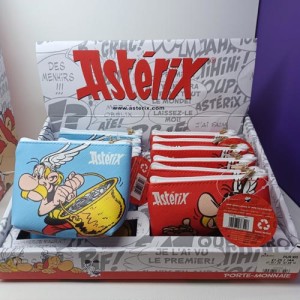 Suppliers seem more switched on to providing retailers with ‘shelf ready’ ways of displaying product effectively and using the space more efficiently. This is particularly true for those selling to independents, specialists and heritage sector retailers. I saw lots of exhibitors presenting display solutions ranging from counter top boxes through to branded spinners.
Suppliers seem more switched on to providing retailers with ‘shelf ready’ ways of displaying product effectively and using the space more efficiently. This is particularly true for those selling to independents, specialists and heritage sector retailers. I saw lots of exhibitors presenting display solutions ranging from counter top boxes through to branded spinners.
A good example of a company taking this approach is Puckator. A lot of its products are presented in retail ready displays – this encourages retailers to buy into more stock and, of course, gives them retail display solutions. For example, it had a counter top box for Asterix coin purses which features Asterix comic strip and has been designed to help the product stand out on shelf.
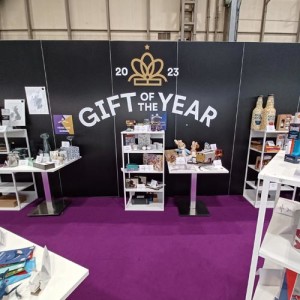 I was very pleased to be a judge for the Gift of the Year awards again this year. I think this is a really good initiative and is a really well run programme. I noticed how exhibitors were embracing it and seemed very proud to be nominated in the awards. Many had signage that celebrated their nominations for 2023 and in some cases the fact that they won awards in 2022. Having the ‘live judging’ at Spring Fair creates a real focus for the awards and ensures that they are a core part of the industry. I think this is a really good example of a trade association shining a light on the industry it represents and creating marketing momentum.
I was very pleased to be a judge for the Gift of the Year awards again this year. I think this is a really good initiative and is a really well run programme. I noticed how exhibitors were embracing it and seemed very proud to be nominated in the awards. Many had signage that celebrated their nominations for 2023 and in some cases the fact that they won awards in 2022. Having the ‘live judging’ at Spring Fair creates a real focus for the awards and ensures that they are a core part of the industry. I think this is a really good example of a trade association shining a light on the industry it represents and creating marketing momentum.
Being a judge also allowed me to see a broad cross section of products from a range of categories. What struck me about the products on the shortlists was the high standard of entries. It was a difficult competition to judge, but it was very encouraging to see the quality that is coming through in the gift industry. I am sure the awards are inspiring companies to push their products on and encouraging to strive for higher standards. There is a value in being nominated and winning.
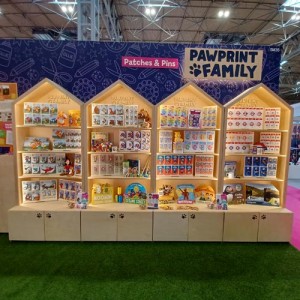 I certainly felt that there were more products on show that had been developed in associations with charities.
I certainly felt that there were more products on show that had been developed in associations with charities.
Half Moon Bay is a good example of a company that has embraced the charity sector and developed product ranges with the likes of the RSPB. Of course, traditionally there has long been a link between the charity sector and greetings cards. Companies like Museums & Galleries had Christmas card ranges that are sold in conjunction with charities on its stand. But a further sign that this approach to business is becoming more mainstream was the presence of Pawprint Family, a young company that is working with licences such as Wallace & Gromit, Care Bears and The Gruffalo to create pin badges and patches. In turn, Pawprint Family works with charity partners to sell products, but it also has its own charitable trust that benefits from some of the revenues generated by the company. It uses this to make grants to young people looking for funding to participate in educational and travel programmes internationally.
It was also good to see Labre’s Hope at Spring Fair. I first met the company at Top Drawer and was really impressed by the business. It employs homeless people to make soaps for the gift sector and does this in conjunction with homeless charity Crisis. It is a really good example of a social enterprise business with a real purpose behind it. Another example of this linkage between manufacturers, IP and charities was Enesco’s range of Peter Rabbit plush which raises funds for Great Ormond Street Hospital.
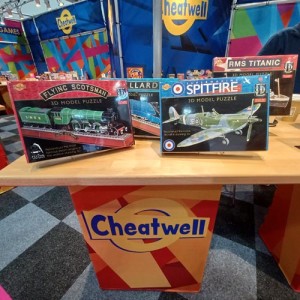 Related to this is the increasing presence of products that feature licences sourced from the museum and galleries sector. There was a real variety of product featuring heritage brands.
Related to this is the increasing presence of products that feature licences sourced from the museum and galleries sector. There was a real variety of product featuring heritage brands.
Noteworthy examples included a Flying Scotsman 3D model puzzle from Cheatwell and a Natural History Museum inspired confectionery range from Crème D’Or.
Heritage brands have made it easier for licensees to work with them, not least in terms of design with more assets becoming available.
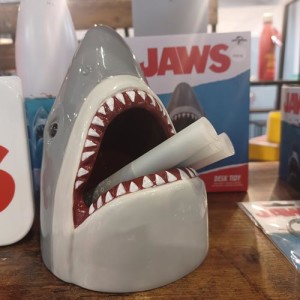 It was also good to see companies investing more in product development and using licensing to add value.
It was also good to see companies investing more in product development and using licensing to add value.
A great example of this approach is the way Half Moon Bay has created a strong range of 3D shaped ceramic mugs. It uses licensing well in this category. A great example of this was its JAWS mug.
Part of a wider range of JAWS giftware, this item really stood out and am sure attracted the attention of retailers. It is also an item that allows retailers to create impactful displays and to build a range around.
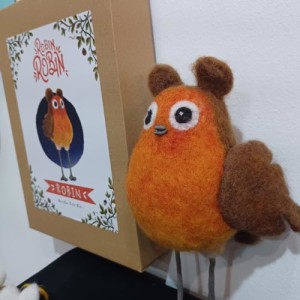 Crafting was also a recurring theme throughout the show. Maybe a legacy of lockdown, but there certainly seemed to be more companies selling products related to arts and crafts. Many of these included kits that include all the elements to complete a project.
Crafting was also a recurring theme throughout the show. Maybe a legacy of lockdown, but there certainly seemed to be more companies selling products related to arts and crafts. Many of these included kits that include all the elements to complete a project.
First time exhibitor The Makerss featured licensed products including Robin Robin and Percy the Park Keeper. Licensing allows it to explore new routes to market, to reach new consumers and also work collaboratively with other licensees. It was also interesting to see publishers like Search Press at the show. Its publishing portfolio is 100% focused on arts and crafts. It was also interesting to see long-term publishing licensee Alligator featuring a licence like Crayola in its range and also incorporating art-themed products in ranges such as its Bluey programme.
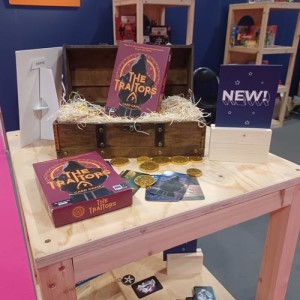 Another observation was that companies seem more able to move more quickly. Ginger Fox featured a boxed card game based on the successful TV series The Traitors (albeit the TV show was based on a card game and this new product was an adaptation of that) – the show was only on air a few weeks ago and has become very popular very quickly. In the ‘old days’ it may have taken a while for this product to reach the market and to be on show at an event like Spring Fair. There seems to be a wider acceptance by rights owners, manufacturers and retailers that sometimes timelines need to be reduced and products brought to market more quickly. New media platforms and changes in media consumption have meant that licensing hits can emerge more rapidly. I think this will also open up opportunities for more UK developed product as people find ways to reduce lead times. Likewise, IP owners may need to think about their processes and how they can speed these up – for example around approvals and contracts.
Another observation was that companies seem more able to move more quickly. Ginger Fox featured a boxed card game based on the successful TV series The Traitors (albeit the TV show was based on a card game and this new product was an adaptation of that) – the show was only on air a few weeks ago and has become very popular very quickly. In the ‘old days’ it may have taken a while for this product to reach the market and to be on show at an event like Spring Fair. There seems to be a wider acceptance by rights owners, manufacturers and retailers that sometimes timelines need to be reduced and products brought to market more quickly. New media platforms and changes in media consumption have meant that licensing hits can emerge more rapidly. I think this will also open up opportunities for more UK developed product as people find ways to reduce lead times. Likewise, IP owners may need to think about their processes and how they can speed these up – for example around approvals and contracts.
All in all I think this was three days well spent – well done to the organisers and exhibitors. I thought the Spring Fair was a great showcase for the gift industry and it was good to see that licensing is playing its part. I think there are a lot of positives to take out of the show not least the quality of products on offer, the way manufacturers are working harder to be ‘retailer ready’ and the fact that there is more imagination being shown in the use of licensing.
Ian Downes runs Start Licensing, an independent brand licensing agency. His Twitter handle is @startlicensing – he would welcome your suggestions for what to look out for.































